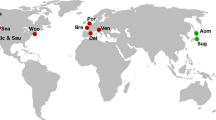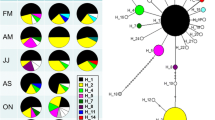Abstract
We studied the diversity of clonal lineages in US populations of the New Zealand mudsnail (Potamopyrgus antipodarum), focusing on the western states, using three different types of genetic markers: mtDNA, allozymes, and microsatellite DNA (msDNA) (Dybdahl and Drown in Biol Invasions 13:1663–1672, 2011). The comment by Hershler et al. (Biol Invasions, doi:10.1007/s10530-012-0184-2, 2012) raises issue with our msDNA data, claiming that we underestimated genotypic diversity. We chose to focus on msDNA alleles within the size range previously identified in several earlier studies of P. antipodarum, in order to increase the likelihood that we were scoring homologous amplification products. In contrast, Hershler et al. Biol Invasions 13:1663–1672, (2010) claimed that they identified alleles that are much larger, indicating greater genotypic diversity in one region (Snake River, ID). In our view, their results stand in contrast to previous work on msDNA diversity and mutational processes, which raises the issue that some of the very large fragments that they claimed were msDNA alleles may be been non-homologous amplification products. Nevertheless, the results of the two papers and analyses agree on the main conclusion of our paper: that only a few clonal lineages are present in the Snake River, Idaho, one of which is very common.
Similar content being viewed by others
References
Dybdahl MF, Drown DM (2011) The absence of genotypic diversity in a successful parthenogenetic invader. Biol Invasions 13:1663–1672
Dybdahl MF, Kane SL (2005) Adaptation versus environmental tolerance in the success of a clonal invader. Ecology 86:1592–1601
Hauser L, Carvalho G, Hughes R (1992) Clonal structure of the introduced freshwater snail Potamopyrgus antipodarum (Prosobranchia: Hydrobiidae), as revealed by DNA fingerprinting. Proc Biol Sci 249(1324):19–25
Hershler R, Liu H-P, Clark WH (2010) Microsatellite evidence of invasion and rapid spread of divergent New Zealand mudsnail (Potamopyrgus antipodarum) clones in the Snake River basin, Idaho, USA. Biol Invasions 12:1521–1532
Hershler R, Liu H-P, Clark WH (2012) Comments on “The absence of genotypic diversity in a successful parthenogenetic invader” by Mark Dybdahl and Devin Drown [Biological Invasions 13 (2011), 1663–1672]. Biol Invasions. doi:10.1007/s10530-012-0184-2
Neiman M, Lively CM (2004) Pleistocene glaciation is implicated in the phylogeographical structure of Potamopyrgus antipodarum, a New Zealand snail. Mol Ecol 13:3085–3098
Weetman D, Hauser L, Carvalho GR (2001) Isolation and characterization of di- and trinucleotide microsatellites in the freshwater snail Potamopyrgus antipodarum. Mol Ecol Notes 1:185–187
Weetman D, Hauser L, Carvalho GR (2002) Reconstruction of microsatellite mutation history reveals a strong and consistent deletion bias in invasive clonal snails, Potamopyrgus antipodarum. Genetics 162:813–822
Weetman D, Hauser L, Carvalho GR (2006) Heterogeneous evolution of microsatellites revealed by reconstruction of recent mutation history in an invasive apomictic snail, Potamopyrgus antipodarum. Genetica 127:285–293
Author information
Authors and Affiliations
Corresponding author
Rights and permissions
About this article
Cite this article
Dybdahl, M.F., Drown, D.M. Response to comments on “The absence of genotypic diversity in a successful parthenogenetic invader” by Mark Dybdahl and Devin Drown [Biological Invasions 13 (2011), 1663–1672]. Biol Invasions 14, 1647–1649 (2012). https://doi.org/10.1007/s10530-012-0185-1
Received:
Accepted:
Published:
Issue Date:
DOI: https://doi.org/10.1007/s10530-012-0185-1




